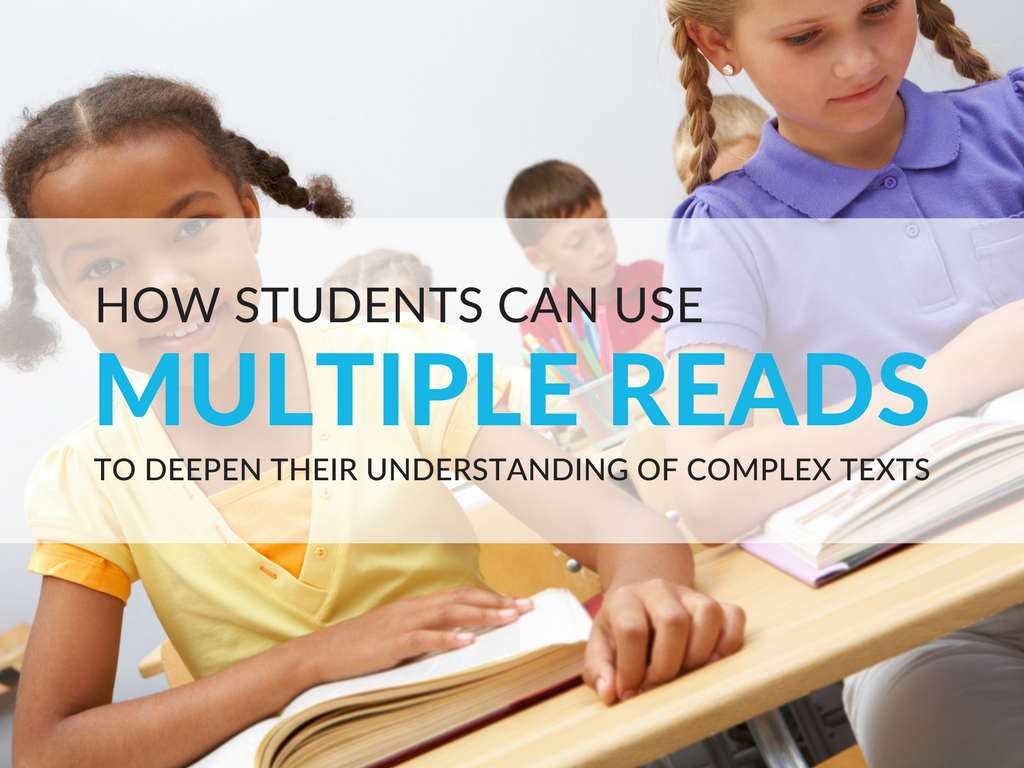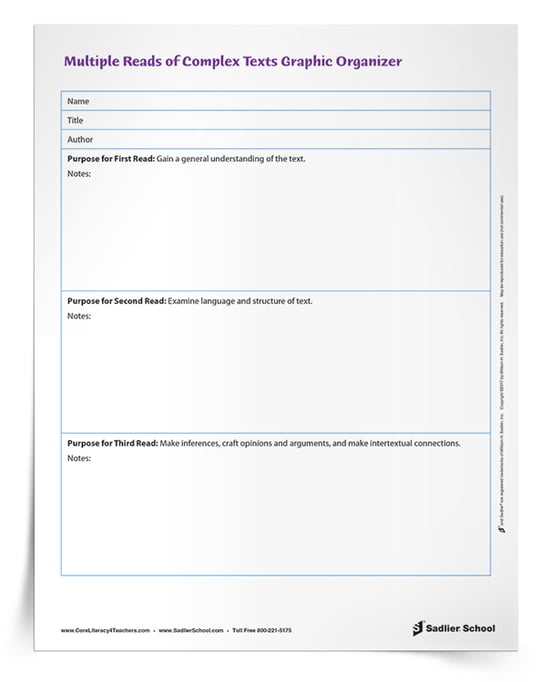December 20, 2017 ELA PD - Literacy, ELA K-5, ELA 6-8, ELA Focus - Close Reading, ELA Resources - Graphic Organizers, Core Literacy
The Purposes for Multiple Reads in Close Reading Lessons
By: Erin Lynch
Having your students do multiple reads of a text (that is, re-reading more closely with a specific purpose for each read) is an excellent way to deepen their understanding of the meaning of text!
Download the Multiple Reads of Complex Texts Graphic Organizer now!
Close reading is when a reader reads a text multiple times in order to analyze its details so as to make interpretations and develop a deep understanding of the text. It is looking closely at how an author's ideas unfold through a text by examining the plot, vocabulary, syntax, structure, and/or point of view through multiple re-readings of a piece of literature information text.

MAKING THE CASE FOR CLOSE READING IN EVERY CLASSROOM
When I ask my colleagues why close reading is not used more frequently in their reading classes, I am usually given the following two reasons.
REASON #1
There is barely enough time to get through the curriculum, so there is certainly not enough time to be rereading material.
REASON #2
Students do not like to reread a text. Sometimes it is a challenge just to get them to do the first reading.
And here's my response...
First, I agree that many districts have reading curricula in place that teachers cannot possibly complete in 180 school days. However, this is why we need to teach smart. If you give your students practice during the first half of the year with analyzing the details of a text by looking closely at the plot, vocabulary, syntax, structure, and point of view through multiple reads, you are setting them up to be able to do this more independently during the second half of the school year. With a focus on fostering close reading habits in the beginning of the year you are building strong readers that will be able to interpret a text on a high level independently. Our goal should be to develop strong readers with strategies they will be able to use throughout their lives to better understand a text. In other words, we should prioritize ”depth over breadth.”
Not every text should be part of the close reading process. Text selection is critical to successful close reading lessons. Selected texts should be short, complex, and of a variety of genre. Text selection needs to be made carefully and purposefully.
SETTING UP CLOSE READING LESSON PLANS
Close reading lesson plans can be set up in different formats. If you are familiar with this blog, you know I like to structure my close reading lesson plans over a four-day period. Close reading can be very difficult for elementary grade level students, so modeling and practice is essential. I believe the best close reading lessons plans use a scaffolded approach to instruction:
- “I do” (the teacher provides explicit instruction and/or modeling)
- “We do” (the teacher and the students practice together)
- “You do” (the students independently practice the skill)
In every close reading lesson plan that I write, I have the students read focusing on a specific lens.
- Examine the layers of meaning (comprehension)
- Look for great words (language/vocabulary/diction)
- Analyze the author’s craft (the writing style and choices the author made)
- Identify the point of view the story is being told from and its impact on the text (1st, 2nd, or 3rd person point of view)
- Notice the text structure and its tone (argumentative, humorous, sentimental, etc.)
WHAT THE EXPERTS SAY ABOUT MULTIPLE READS OF A COMPLEX TEXT
Recently, I read the book Turning the Page on Complex Texts: Differentiated Scaffolds for Close Reading Instruction by Diane Lapp, Barbara Moss, Maria C. Grant, and Kelly Johnson. Here is a brief synopsis:
Ensure all learners become successful close readers. In this powerful resource, the authors examine what features make a text complex. Learn how to select appropriate complex texts and design instruction to meet the needs of every student. Explore grade-specific classroom scenarios that illustrate how to scaffold lessons to foster close reading and deepen comprehension at all stages of K–12 education.
Benefits
-
Gain practical teaching strategies for creating close reading lessons.
-
Consider grade-level-specific instructional scenarios that illustrate how to support students’ reading comprehension as they learn to read closely.
-
Learn how to evaluate a text’s complexity and how to ask text-dependent questions that can help students understand the deeper meaning of the text.
-
Study evidence for why continuous assessment of student performance is vital for making sure all students learn to closely read complex texts.
-
Discover potential contingency scaffolds for the classroom and how to use them to promote student success in closely reading a text.
In this book, the authors focus on three purposes for each multiple read. These three purposes ensure that students use each multiple read to digest and deepen their understanding of complex text. The three purposes of multiple reads are:
PURPOSE FOR 1ST READ
Gaining a general understanding of the text.
PURPOSE FOR 2ND READ
Examine language and structure of text.
PURPOSE FOR 3RD READ
Make inferences, craft opinions and arguments, and make intertextual connections.
Since reading this book I've been using this new format for multiple reads in my classroom. To assist my students I created a graphic organizer based on the three purposes for each read mentioned above.
GRAPHIC ORGANIZER FOR MULTIPLE READS OF A COMPLEX TEXT
I use this organizer two ways. First, I use it to assist making my instructional plans. Second, I collect data and write observational notes on how students are understanding the text. The organizer is a great way for students to take notes as they complete each multiple read of a complex text. Download the Multiple Reads of Complex Text Graphic Organizer now.
IN SUMMARY
In the education field, there are always new ways to instruct students. This last summer I researched different strategies for creating close reading lessons and found the book, Turning the Page on Complex Texts: Differentiated Scaffolds for Close Reading Instruction by Diane Lapp, Barbara Moss, Maria Grant and Kelly Johnson, to be an invaluable resource.
By learning different approaches to close reading instruction I am better equipped to help my students closely read complex texts successfully. I've been following the approach established by these experts on close reading to enhance multiple reads and ensure students read with a purpose!




